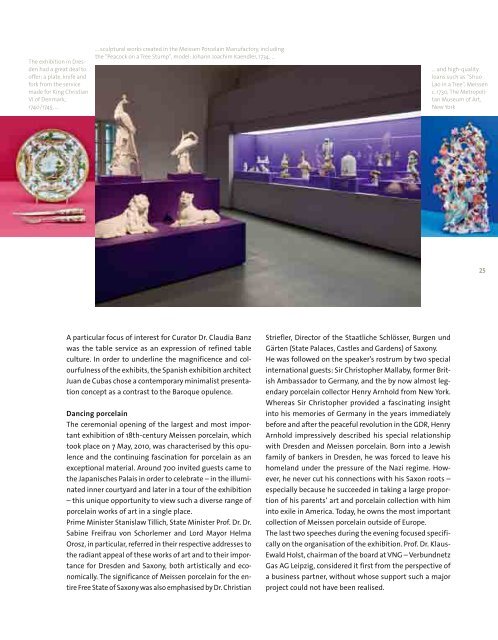Annual Report 2010 - Staatliche Kunstsammlungen Dresden
Annual Report 2010 - Staatliche Kunstsammlungen Dresden
Annual Report 2010 - Staatliche Kunstsammlungen Dresden
Create successful ePaper yourself
Turn your PDF publications into a flip-book with our unique Google optimized e-Paper software.
The exhibition in <strong>Dresden</strong><br />
had a great deal to<br />
offer: a plate, knife and<br />
fork from the service<br />
made for King Christian<br />
Vi of Denmark,<br />
1740/1745, …<br />
… sculptural works created in the Meissen Porcelain Manufactory, including<br />
the “Peacock on a Tree stump”, model: Johann Joachim Kaendler, 1734, …<br />
A particular focus of interest for Curator Dr. Claudia Banz<br />
was the table service as an expression of refined table<br />
culture. In order to underline the magnificence and colourfulness<br />
of the exhibits, the Spanish exhibition architect<br />
Juan de Cubas chose a contemporary minimalist presentation<br />
concept as a contrast to the Baroque opulence.<br />
Dancing porcelain<br />
The ceremonial opening of the largest and most important<br />
exhibition of 18thcentury Meissen porcelain, which<br />
took place on 7 May, <strong>2010</strong>, was characterised by this opulence<br />
and the continuing fascination for porcelain as an<br />
exceptional material. Around 700 invited guests came to<br />
the Japanisches Palais in order to celebrate – in the illuminated<br />
inner courtyard and later in a tour of the exhibition<br />
– this unique opportunity to view such a diverse range of<br />
porcelain works of art in a single place.<br />
Prime Minister Stanislaw Tillich, State Minister Prof. Dr. Dr.<br />
Sabine Freifrau von Schorlemer and Lord Mayor Helma<br />
Orosz, in particular, referred in their respective addresses to<br />
the radiant appeal of these works of art and to their importance<br />
for <strong>Dresden</strong> and Saxony, both artistically and economically.<br />
The significance of Meissen porcelain for the entire<br />
Free State of Saxony was also emphasised by Dr. Christian<br />
Striefler, Director of the <strong>Staatliche</strong> Schlösser, Burgen und<br />
Gärten (State Palaces, Castles and Gardens) of Saxony.<br />
He was followed on the speaker’s rostrum by two special<br />
international guests: Sir Christopher Mallaby, former British<br />
Ambassador to Germany, and the by now almost legendary<br />
porcelain collector Henry Arnhold from New York.<br />
Whereas Sir Christopher provided a fascinating insight<br />
into his memories of Germany in the years immediately<br />
before and after the peaceful revolution in the GDR, Henry<br />
Arnhold impressively described his special relationship<br />
with <strong>Dresden</strong> and Meissen porcelain. Born into a Jewish<br />
family of bankers in <strong>Dresden</strong>, he was forced to leave his<br />
homeland under the pressure of the Nazi regime. However,<br />
he never cut his connections with his Saxon roots –<br />
especially because he succeeded in taking a large proportion<br />
of his parents’ art and porcelain collection with him<br />
into exile in America. Today, he owns the most important<br />
collection of Meissen porcelain outside of Europe.<br />
The last two speeches during the evening focused specifically<br />
on the organisation of the exhibition. Prof. Dr. Klaus<br />
Ewald Holst, chairman of the board at VNG – Verbundnetz<br />
Gas AG Leipzig, considered it first from the perspective of<br />
a business partner, without whose support such a major<br />
project could not have been realised.<br />
… and high-quality<br />
loans such as “shuo<br />
Lao in a Tree”, Meissen<br />
c. 1730, The Metropolitan<br />
Museum of art,<br />
New York<br />
25

















